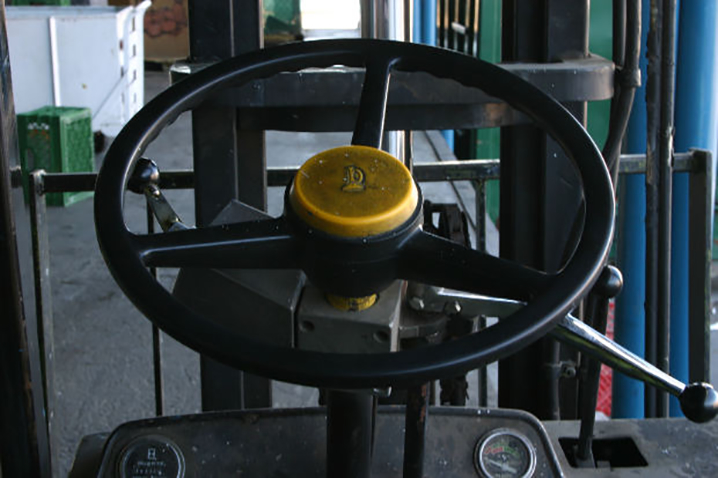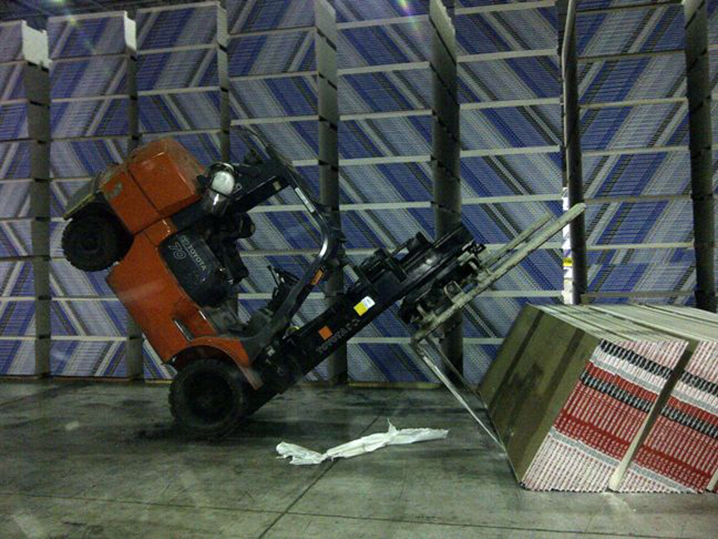Forklift Operations
How to Operate the Forklift
Operating a forklift isn’t hard to learn, but it must be operated with care. It’s much like operating a normal car since it has a steering wheel and the same type of accelerator; however, don’t be fooled by thinking it’s easy to operate. Even though a forklift may look like it’s easy to operate, all of the safety guidelines must be followed carefully. A forklift is still a large, heavy and dangerous machine. Begin every day with a daily inspection which includes confirming that all of the safety equipment is working correctly. This includes: the seat belt, warning light, backup alarm and horn.

Weight distribution is very important when operating a forklift because of the way it’s built. If the weight of the load is not distributed properly, then the load can fall off, or even tip over. Because of the way they are built, they are steered by front wheels.
Two of the main keys of operating a forklift are to take it slow and steady. This machine is very complex and it must be driven slow on even areas. This can’t be stressed enough: operating a forklift at a high acceleration or any other careless actions can lead to fatal consequences. In addition, forklifts are expensive, so any careless behavior or neglect can be a huge issue within some organizations – especially small businesses.

Checklists
It is essential that checklists are completed before operation and for regular maintenance of the forklift. This should be one of the main items completed to meet safety regulations. Some of the most important items include:
- Load capacity – make sure the forklift is not overloaded
- Check both the foot brakes and hand brakes
- Ensure that there is enough fuel
- Check the oil level and look for any leakage
- Check the tires and ensure the tire pressure is at a safe level
- Check the lights and horn
- Ensure that the fork is lifting properly
- Check the engine for any issues
When parking the forklift at the end of a shift, it must be parked in a safe area and the fork has to be level with the ground. The parking brake should also be set and the directional control should be set at neutral.
Driving the forklift
Once the pre-checklist has been completed, it is important to know how the start button and how to use all of the controls, as well as what the meter readings mean. Before driving the forklift, the fork must be set to the proper width depending on what is being loaded. The lift should be only be lifted to the exact height that is needed to move it. This will help balance the weight appropriately.
The forklift is started by inserting the key and pressing the ‘start’ button. The controls include the following:
- Control lever
- Accelerator
- Brake
- Parking brake
Maintaining control
When operating a forklift, the driver must be in control at all times. Here are some important things to remember when it comes to maintaining control:
When handling pallets, the forks must be:
- High enough to go onto the pallet
- Be level at all times
- Set at the proper width so there is an even weight distribution
When steering, you must:
- Turn the rear wheels
- Carry the load by the front wheels
When driving in reverse, you must:
- Sound the horn
- Drive slowly
- Don’t move if your vision is blocked
- Face the rear
When travelling uphill or downhill:
- Do not turn (You must be on level ground to turn)
- The fork should point downhill without a load
- The fork should point uphill with a load
When travelling in general:
- Always tilt your load backwards
- Travel with the forks as close to the ground as possible
- Obey all signs
- Don’t stop suddenly
- Drive slowly and watch for pedestrians
- Do not turn while on a ramp
- Do not move the load higher when at an incline
Refueling or recharging
When it’s time to refuel or recharge your forklift, it must be done safely because of the great increase of fire damage and/or injuries. In order to safely do this, the following four steps must be taken:
- Ensure that the forklift is in the safe, designed are for refueling or recharging
- The area must be ventilated well
- A fire extinguisher should be in this area
- Ensure not to block any doorways, emergency equipment or production access
Loading and unloading
When it comes time to load or unload items, it’s important to check and make sure it’s a safe area before doing anything else. Carefully inspect the floor to ensure it will support both the forklift and weight of the load.
